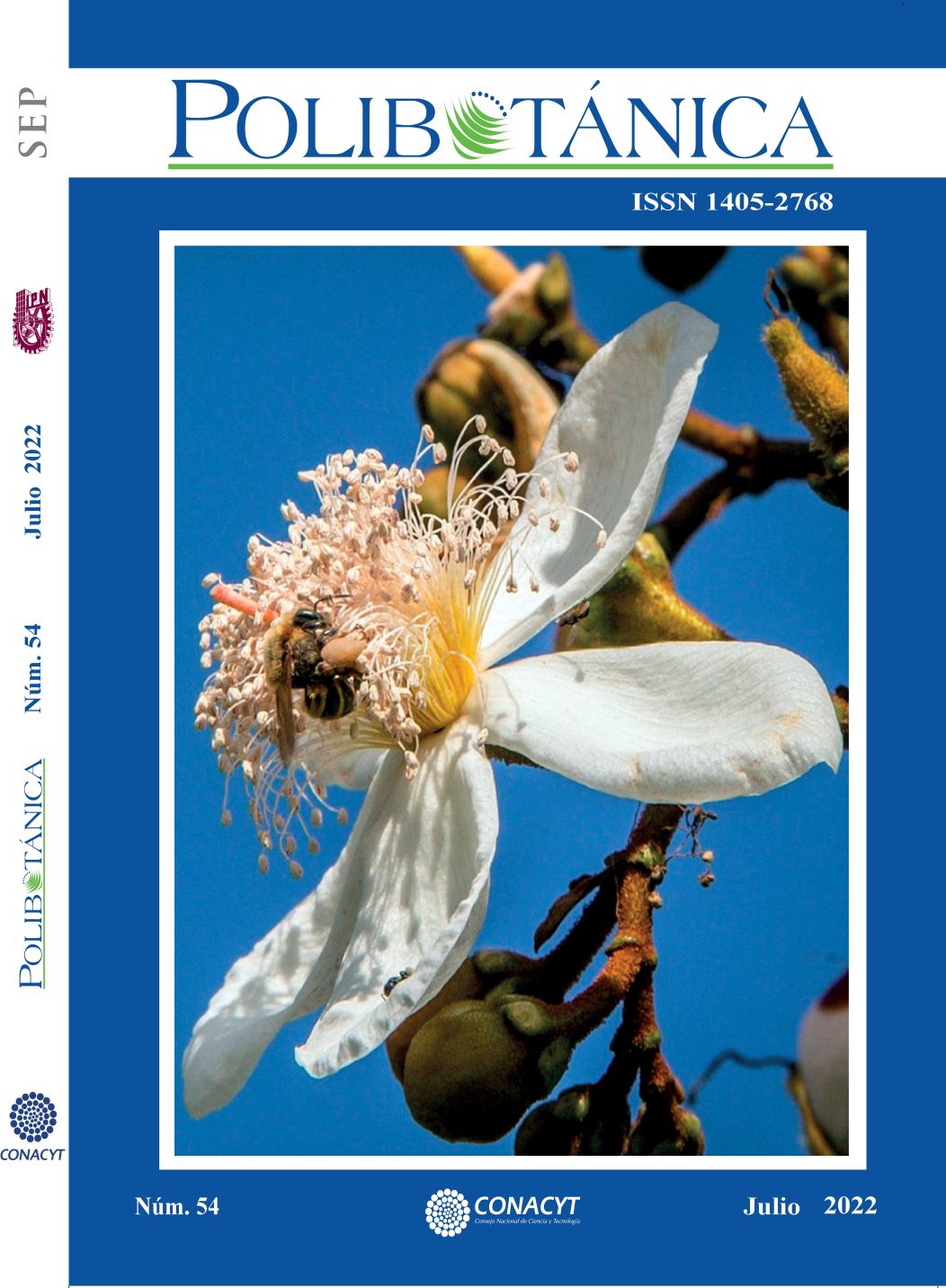Effect of coverage and edaphic conditions in Amoreuxia wrightii A. Gray, in northeastern Mexico
DOI:
https://doi.org/10.18387/polibotanica.54.6Keywords:
canonical correspondence analysis, cover, bulk density, disturbance, danger of extinction, clay soilAbstract
Amoreuxia wrightii herbaceous species cataloged in NOM-059-SEMARNAT-2010 as endangered; traditionally it has been used medicinally to counteract various diseases. This study aims to determine the effect of canopy cover as well as the edaphic conditions where Amoreuxia wrightii develops. For this, two areas were evaluated, one with disturbance and the other without apparent disturbance; eight sites of 10 m x 10 m in each area to determine the importance value index, diversity, physical and chemical characteristics of the soil to perform a canonical correspondence analysis. There were no differences in the areas, for the variables of density (p = 0.13), basal area (p = 0.094) and timber volume (p = 0.216); but yes, for the crown area (p <0.001), the area without disturbance being larger. For the disturbed area, the diversity was low while for the undisturbed area it was medium. Shannon diversity differed between areas (t = 3.79; g.l. = 406). The canonical correspondence analysis showed that Amoreuxia wrightii is associated with shrub species such as Croton cortesianus, Vachellia farnesiana and Vachellia rigidula in addition to preferring clayey soils with high values of apparent density. Amoreuxia wrightii is only found in disturbed areas where coverage is minimal, associated with clayey soils with high apparent density.
References
Baev, P.V. y Penev, L. D. . (1995). BIODIV: program for calculating biological diversity parameters, similarity, niche overlap, and cluster analysis (5.1; p. 57). Pensoft, Sofia-Moscow.
Calderón de Rzedowski G. (1994). Cochlospermaceae. Flora del Bajío y de regiones adyacentes. Fasículo 2, 1–5.
Castellanos JZ, Uvalle JX, A. A. (2000). Manual de interpretación de análisis de suelos y aguas (2a edición). Instituto de Capacitación para la Productividad Agrícola.
Castro-Montoya JA, Zayas-Barreras RA, Sainz-Aguilar P, Romero-Lozoya M, Bojórquez-Camacho FR, B.-C. O. (2012). El consumo de la zaya (Amoreuxia spp) una tradición cultural de la región del Évora en el estado de Sinaloa, México. Revista Mexicana de Agronegocios, 30, 898-907. https://doi.org/10.23913/ricea.v1i2.11
Cedano-Maldonado M, V.-I. L. (2004). Usos y nombres comunes de las especies de Cochlospermaceae en México. Etnobiología, 4, 73-88.
Chávez J, Lapp M, Torrecilla P, Wingfield R, G. L. (2016). Aspectos biológicos y poblacionales con relación al estado de amenaza local de Amoreuxia wrightii A. Gray (Bixaceae), especie de distribución restringida en Venezuela. Ernstia, 26(1), 39-73.
Correll, D. S. y M. C. J. (1970). Manual of the vascular plants of Texas. (Texas Research Foundation, Renner (ed.)).
Correll DS, J. M. (1970). Manual of the vascular plants of Texas. Texas Research Foundation.
Cutler DF. (1977). Applied plant anatomy. Longman.
De Sousa-Pereira DM, De Sousa-Pereira M, E.-B. A. (2013). Effect of light and temperature on seed germination of Cochlospermum vitifolium (Will.) Sprengel. Floresta e Ambiente, 20(3), 391–397.
Eduardo Estrada; Yen Méndez, Carmen; Delgado Salinas, Alfonso; Villarreal Quintanilla, J. A. (2004). Legumiosas del centro del estado de Nuevo León, México. Anales Del Instituto de Biología. Serie Botánica, 75(1). http://www.redalyc.org/html/400/40075105/
Figueroa Y, G. G. (2007). Lista comentada de las plantas vasculares del Enclave Seco Interandino de la Tatacoa (Huila, Colombia). Caldasia, 29(2), 263–281. https://doi.org/10.21829/abm73.2005.1003
Günther KF. (1986). Amoreuxia wrightii A. Gray (Cochlospermaceae) neufür Cuba. Feddes Repert, 97(1), 73–78.
INEGI. (2009). Prontuario de información geográfica municipal de los Estados Unidos Mexicanos.
Jost, L. (2006). Entropy and di v ersity. 2.
Lu SG, Malik Z, Chen DP, W. C. (2014). Porosity and pore size distribution of Ultisols and correlations to soil iron oxides. Catena, 123, 79–87. https://doi.org/10.1016/j.catena.2014.07.010
Magurran AE. (1988). Ecological diversity and its measurement. Princeton UniversityPress.
McPhee JE, Aird PL, Hardie MA, C. S. (2015). The effect of controlled traffic on soil physical properties and tillage requirements for vegetable production. Soil and Tillage Research, 149, 33–45.
Moreno, C. (2001). Métodos para medir la biodiversidad. (M.-M. y T. SEA. (ed.); Vol. 1).
Mueller-Dombois D, E. H. (1974). Aims and methods of vegetation ecology. John Wiley.
Ott, L. (1993). An introduction to statistical methods and data analysis (2nd ed.). Duxbury Press.
Palmer E. (1878). Plants used by the Indians of the United States. The American Naturalist, 12, 593–606 y 646–655. https://doi.org/10.1086/272200
Sánchez, S. O., Islebe, G. A. y V.-H. M. (2007). Flora y caracterización de gremios ecológicos en distintos estados sucesionales de la selva mediana de Quintana Roo. Foresta Veracruzana, 9(2), 17–26.
SEMARNAT [Secretaría de Medio Ambiente y Recursos Naturales]. (2002). 2002. Norma Oficial Mexicana NOM-021-RECNAT-2000. Establece las especificaciones de fertilidad, salinidad y clasificación de suelos. Estudios, muestreos y análisis. In Diario Oficial de la Federación. 31 de diciembre de 2002 (segunda).
SEMARNAT [Secretaría de Medio Ambiente y Recursos Naturales]. (2010). NORMA Oficial Mexicana NOM-059-SEMARNAT-2010, Protección ambiental-Especies nativas de México de flora y fauna silvestres-Categorías de riesgo y especificaciones para su inclusión, exclusión o cambio- Lista de especies en riesgo. Diario Oficial de la Federación.
Soto-Mata B, Alanís-Rodríguez E, Jurado E, Pando-Moreno M, Molina-Guerra V, Alcalá-Rojas A, M.-C. J. (2018). Caracterización del hábitat de Amoreuxia wrightii (Bixaceae), una especie en peligro de extinción en el noreste de México. Acta Botanica Mexicana, 122, 21–31.
Ter-Braak W, Š. P. (2002). CANOCO. Reference manual and CanoDraw for Windows User’s Guide: Software for Canonical Community Ordination (4.5). Microcomputer Power, Ithaca.
Van-Devender TR, R.-G. A. (2013). Search of Amoreuxia and Echinocactus in Sonora. The Arizona Native Plant Society, 36, 1–3.
Velazco CG. (2009). Flora del estado de Nuevo León, México: Diversidad y Análisis Espacio-Temporal. [Universidad Autónoma de Nuevo León.]. https://doi.org/10.21041/conpat2019/v2pat327
Molina-Guerra VM, Mora-Olivo A., Alanís-Rodríguez E., Soto-Mata B.E., Patiño-Flores A. M. (2019). Plantas caracteristicas del matorral espinoso tamaulipeco en México (Editorial Universitaria de la Universidad Autónoma de Nuevo León (ed.)).
Whittaker R. (1972). Evolution and measurement of species diversity. Taxon, 21, 213–251.
Woerner M. (1989). Métodos químicos para el análisis de suelos calizos de zonas áridas y semiáridas. Universidad Autónoma de Nuevo León.
Downloads
Published
Issue
Section
License

Polibotánica by Departamento de Botánica de la Escuela Nacional de Ciencias Biológicas del Instituto Politécnico Nacional se distribuye bajo una Licencia Creative Commons Atribución-NoComercial-CompartirIgual 4.0 Internacional.




















